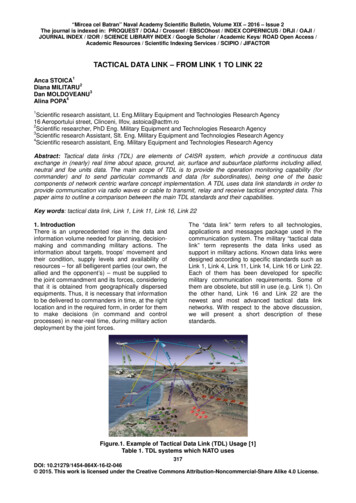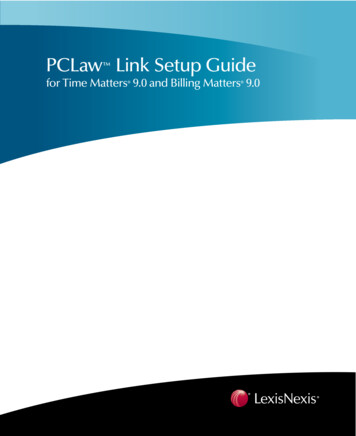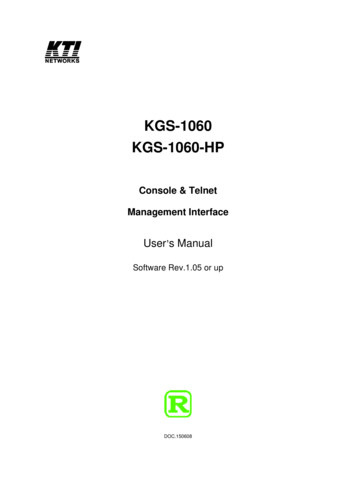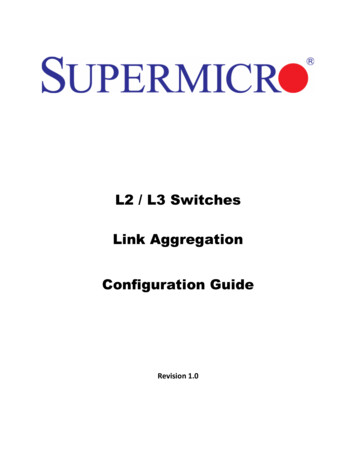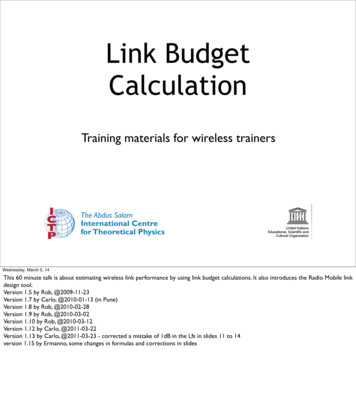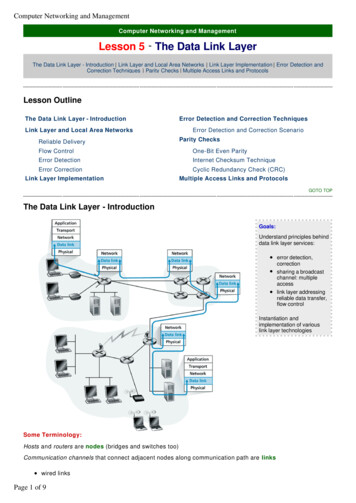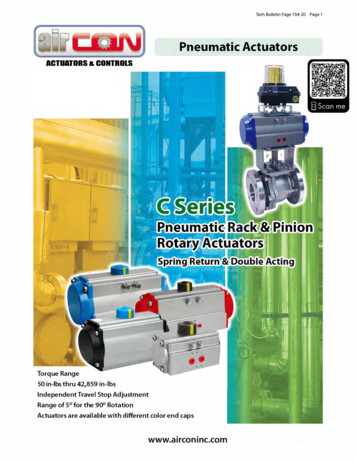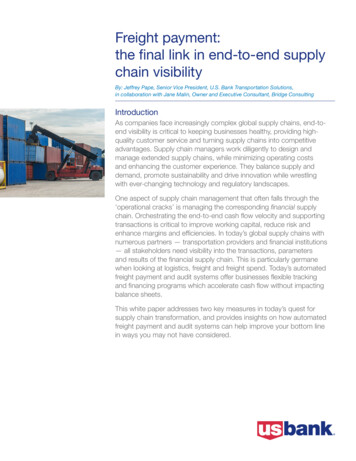
Transcription
Freight payment:the final link in end-to-end supplychain visibilityBy: Jeffrey Pape, Senior Vice President, U.S. Bank Transportation Solutions,in collaboration with Jane Malin, Owner and Executive Consultant, Bridge ConsultingIntroductionAs companies face increasingly complex global supply chains, end-toend visibility is critical to keeping businesses healthy, providing highquality customer service and turning supply chains into competitiveadvantages. Supply chain managers work diligently to design andmanage extended supply chains, while minimizing operating costsand enhancing the customer experience. They balance supply anddemand, promote sustainability and drive innovation while wrestlingwith ever-changing technology and regulatory landscapes.One aspect of supply chain management that often falls through the‘operational cracks’ is managing the corresponding financial supplychain. Orchestrating the end-to-end cash flow velocity and supportingtransactions is critical to improve working capital, reduce risk andenhance margins and efficiencies. In today’s global supply chains withnumerous partners — transportation providers and financial institutions— all stakeholders need visibility into the transactions, parametersand results of the financial supply chain. This is particularly germanewhen looking at logistics, freight and freight spend. Today’s automatedfreight payment and audit systems offer businesses flexible trackingand financing programs which accelerate cash flow without impactingbalance sheets.This white paper addresses two key measures in today’s quest forsupply chain transformation, and provides insights on how automatedfreight payment and audit systems can help improve your bottom linein ways you may not have considered.
Freight payment visibility is mission-critical for supplychain transformationSupply chain managers are responsible for communicating, negotiating andcoordinating transactions with business partners and service firms across awide range of sectors, including transportation. Increasingly, they use automatedinformation and distribution management solutions to measure their results andaccomplish their goals.Visibility into freight payments is an important part of the equation. An electronicinvoice processing and payment solution can help meet the complex challenge ofmanaging and optimizing global operations by providing visibility across facilities,countries, divisions and cost centers.Freight payment systems show true landed costs and provide the ability to measurefreight costs at the product level. Because transportation is procured like any otherservice, its impact on the supply chain — and the company’s bottom line — mustbe measurable in order to be managed effectively and optimized successfully.For example, in January you put together an RFP with the aim of saving 15%this year by re-bidding all your freight contracts. At the end of the year, how doyou know if you delivered? The visibility you get with an end-to-end electronicfreight payment solution can paint a complete picture of the costs, allowing youto benchmark your performance against your own actual data, and set futureprocurement budgets with a laser-sharp focus.Getting a balanced view of overall freight payments impacts two critical metricsfor today’s supply chain professional: Cash-to-Cash cycle time, and Perfect OrderFulfillment. This paper will further explore those measures, but first, considerwhy it’s important to drill down to this level of detail to understand the impact oftransportation spend.Changing the focus to an end-to-end perspectiveTo only look at acquiring resources such as inventory, people and equipment intoa facility, reduces focus to just the acquisition piece of the supply chain. Instead,today’s big-picture thinkers realize the need to look at supply chain managementfrom a holistic, end-to-end perspective; one that is driven primarily by thecustomer’s needs and expectations. The Supply Chain Council (SCC) is a globalnonprofit organization whose Supply Chain Operations Reference (SCOR ) Modelprovides a world-standard framework to help organizations make dramatic, rapid,measurable and sustainable improvements in supply chain performance. TheSCOR Model provides a blueprint which enables all stakeholders to address issues,improve performance and communicate across all segments of the supply chain.Page 2 of 9
The SCOR ModelEnd-to-end supply chain visibilitySource: International SupplyChain Council, 12320 BarkerCypress Rd., Suite 600, PMB321, Cypress, TX 77429-8329PlanHigh-performingsupply chains pushthe boundaries fromsuppliers’ suppliersto your iverSourceReturnReturnCustomerInternal or externalCustomers’customerInternal or externalSCOR ModelThe SCOR Model demonstrates that if an organization is not delivering somethingthat the customer is willing to pay for at every step in the supply chain, then theorganization is not as efficient or cost-effective as it could be.How do you measure success?The SCOR Model provides several metrics, including two balanced (internal vs. external)key performance metrics. Cash-to-Cash cycle time is an internally focused measure ofhow well a company is managing its cash and other assets. Perfect Order Fulfillmenthas an external focus on how the customer perceives that company’s performance.Together, these two measures offer a balanced view of how well supply chain goals aremet and how freight payment factors into the equation.Cash-to-Cash cycle time internal measure The SCC’s SCOR Model defines Cash-to-Cash (C2C) cycle time as the time it takes foran investment to flow back into the company after it has been spent for raw materials.In the case of services, this represents the time from the point where a company paysfor the resources consumed in performing the service, to the time the company receivespayment from the customer for those services.Inventorydays ofsupplyDays salesoutstandingDays payableoutstandingC2Ccycle timePage 3 of 9
“When Net 30becomes Net 60 orgreater, imagine howthat positively impactsyour C2C cycle”– Jane H. MalinBridge Consulting“High-performing supply chains minimize the number of days between the time youpay your suppliers (cash out) and the time you receive payment from your customers(cash in),” says Jane H. Malin, owner of Bridge Consulting, an industry expert on supplychain excellence.The bottom line: the shorter the C2C cycle, the more cash is accessible and themore net working capital is available for investment. In today’s business environment,it is critical to keep working capital healthy and flowing smoothly. This includestransportation spend.An automated freight payment system can be used in conjunction with a trade financefeature that targets Days Payable Outstanding (DPO) for shippers by lengtheningthe payment terms for their transactions with freight carriers. Shippers pay carriersaccording to their original terms (and maintain their critical service relationships) whilenot having to pay the cash out until later. “When net 30 becomes net 60 or greater,imagine how that positively impacts your C2C cycle,” says Malin.Let’s look at a simple example. If you pay 100M annually in transportation, considerthe value of having access to that money for 60 or 90 to your typical 30.Assumptions: The organization has a Weighted Average Cost of Capital (WACC) at 10% 100% of transportation payments are extendedThe value ofthe DPO 535,52560 days 1,070,85190 daysPerfect Order Fulfillment customer-focused measureThe SCOR Model defines Perfect Order Fulfillment (POF) as the percentage of ordersmeeting flawless delivery performance and product quality, with complete and accuratedocumentation and no delivery damage. Components include all items and quantitiesdelivered on-time — using the customer’s definition of on-time — and all documentationsuch as packing slips, bills of lading and invoices.POF is a binary decision. “There’s no middle ground when it comes to perfection.It’s either perfect or it’s not,” says Malin. It is achieved if order fulfillment, delivery,documentation and quality are perfect, period. When businesses are looking at acustomer-centric measure like this, they are looking at whether the customer receivedwhat he ordered, when he wanted it, in perfect condition and all aspects of that order,including invoicing and payment were executed perfectly. This perfection inherentlyPage 4 of 9
extends to all documentation and transactions within the financial supply chain as well:order pricing, order confirmations, invoices, cash application, freight invoices, letters ofcredit, export documentation, etc.Total perfectordersTotal numberof orders100%POFWhile some components of the metric may be able to be sustained at very high rates,true POF is very difficult to achieve. Today’s supply chain managers are constantlylooking for help to improve, and measure their improvement, at every step alongthe way.Perceptive supply chain managers have changed their frame of reference to focus onthe customer. They know that the end of their supply chain isn’t the product goingout the door, it’s the receiving and using of that product by the customer — and thatcustomer wants a perfect order experience.An important piece of POF — and one that may have been under appreciated for toolong — is making sure the delivery is perfect. Perfect delivery means the product is ontime, shipped with the right carrier, charged at the right amount, and paid correctly.An automated freight payment solution speaks to the delivery portion of the quest forPOF, providing a fine level of granularity into tracking the time and accuracy elementsof freight payment, invoicing and cash application steps in the order process. Further,a reliable, timely freight payment system supports strong carrier relationships throughpayments that meet contracted terms.Page 5 of 9
Putting it all togetherC2C and POF measurements show the importance of looking at the whole picture ofthe financial supply chain as well as the physical supply chain. An automated freightpayment solution can help organize and provide clarity to the freight aspects of sourcingand acquisition, as well as distribution.Material sourcing and acquisitionConsider inbound freight management. “Clearly from a C2C perspective, you alwayswant to negotiate payables terms for as long a period of time as possible,” says Malin.“The Days Payables Outstanding portion of the C2C equation is subtracted, so thelonger the terms, the more it improves your C2C cycle time.”For instance, typical terms are net 30 days. If terms can be increased to net 60 daysor even 90, working capital is not committed as quickly. It remains available for use fora longer period of time. Through extended term financing through a freight paymentsolution, shippers can extend their payment terms while accelerating payment tothe carrier. For example, a shipper can take 30, 60 or even 90 days to pay, but thecarrier can get paid as soon as the shipper approves the invoice. Leveraging paymentsolution removes a potential friction point — longer billing cycles — from the workingrelationship.Collaborative network solutionCarriersAccelerated paymentTransaction aceU.S. tlementImproved cash flowShippersTransaction informationBusinessintelligenceSupply chainefficiencyDistributionDistribution is a key area where visibility into the freight and transportation logistics iscritical to supply chain results.Businesses negotiate account receivables terms to be as short as possible, with thegoal of receiving payments from customers quickly, thus turning cash more quickly.In order to do that, one needs to understand how much is being paid and when. Thatrequires detailed visibility into freight charges and cycles, and an understanding of howto maximize load efficiency and routing.Freight introduces a number of complex variables: Multiple shipping vendors; the risksinherent in global infrastructure and geopolitical issues; and the challenges of visibilityacross multiple systems and transactions. It is an ongoing challenge to keep controland maximize perfection for each component. Solutions that can assist in doing this arevaluable to optimizing C2C cycle time and POF rates.Page 6 of 9
Putting the right solutions in placeAn integrated, fully electronic freight payment system can help businesses uncover costsavings, increase financial control and gain valuable insight into freight expenditures withmore detailed information at a very fine level of granularity, helping to achieve your Cashto-Cash and Perfect Order Fulfillment goals.Benefits for shippers Uncover cost savings. Increase financial control. Gain valuable insight.Shippers of goods always strive to strengthen their supply chain, reduce costs andincrease efficiency. By providing greater control over the freight payment and auditprocess, an outsourced, electronic freight payment system is designed to makemore effective use of time and resources, lowering costs for shipping and improvingrelationships with their partnering carriers.For shippers, the holy grail is getting one system to process and pay all transactions,providing full visibility at all points of the process to both shipper and carrier. That journeystarts with the basics: 100% auditing of transactions, ensuring 100% accuracy. Chancesare, if shippers are processing paper transactions manually, they’re not checking eachinvoice; thus leaving money on the table and never achieving maximum POF. They needa way to audit every invoice and rate, making sure the carrier is charging an accurateamount. That’s the kind of support an outsourced, electronic audit engine, likeU.S. Bank Freight Payment, can provide.Shippers who use an outsourced, electronic freight payment system:Companies processinginvoices manuallyexperience inaccurateinvoices at a rate threetimes greater than thosethat outsource.2017 American ShipperBenchmark Increase efficiency and enhance control over freight payments while removingwaste, reducing costs and elevating POF Eliminate invoicing errors with freight audit services which improves POF,eliminates rework, and improves C2C Collaborate online with carriers to process, pay and quickly resolve exceptions,enhancing both C2C and POF Improve the flow of data and payments, which is critical to improving visibility andPOF across the supply chain Leverage innovative cash management solutions that allow carriers to receivepayments faster without changing your payment terms and improving C2C Pay only once a month on a consolidated freight invoice reducing risks in POF Maximize small parcel value with improved visibility and control leveragingaccuracy to provide improved customer service and improved POFBenefits for your transportation suppliersFreight carriers run a cash intensive business. Between dealing with driver shortages,managing the cost of rising fuel prices, and dealing with increasingly challenging hoursof-service regulations that increase costs to carriers, the last thing they need is to bechasing down payments from their shippers.Page 7 of 9
U.S. Bank Freight Payment is designed to help carriers avoid payment obstacles,reduce staff time in processing exceptions, and get paid quickly so they keep theirbusinesses moving forward.Carriers can: Decrease days sales outstanding on freight invoices to five or less which improvesthe C2C calculation Collaborate online with shippers to improve accuracy, shorten process time,receive accurate payments and resolve any exceptions as quickly as possible, allimproving both C2C and POF Reduce non-payment risk with freight audit services Improve both C2C and POF by optimizing the flow of invoice processing andpayments, critical to the financial supply chain Receive payments faster with innovative cash management solutions reducingC2C Resolve invoice inquiries with dedicated support service improving POFConclusionToday’s supply chain is long, complex and ultimately leads to the customer. To besuccessful, supply chain practitioners need to manage and measure every activityfrom procurement of raw materials to the point of consumption by the end user. Thesophisticated supply chain represents not only a flow of materials and products, buta flow of financial information that connects all the major business functions in anorganization. End-to-end visibility into these processes and the information flowingbetween them is key to measuring, maximizing and transforming a supply chain into atrue competitive advantage.A global supply chain is actually made up of many smaller supply chains and sub-supplychains. In a constant quest for perfection, supply chain professionals are now identifyingand evaluating each component for optimization and efficiency.The financial supply chain — the financial processes that are tied to the physical supplychain — can also be measured and improved. The SCOR model uses metrics likeCash-to-Cash (C2C) and Perfect Order Fulfillment (POF) to measure the financial flowsrelated to distribution. Specifically invoice processing and payment for transportationservices. Improving this financial supply chain can yield significant operationalefficiencies and savings. Even more importantly, optimizing the working capital within acompany’s supply chain can have a direct positive impact to the bottom line.A best-in-class financial supply chain is the final link to supply chain transformation. Itdelivers efficiencies and optimization, measured by C2C and POF, as well as end-to-endvisibility. The U.S. Bank Freight Payment solution provides best-in-class freight auditand payment, with collaborative, online invoice processing and payment that meets thecomplex challenge of managing and optimizing global operations. Coupled with tradefinance to optimize working capital in the supply chain, this end-to-end solution plays animportant role in today’s supply chain transformation.Page 8 of 9
About U.S. BankFor more than 20 years, organizations have turned to U.S. Bank Freight Paymentfor the service, reliability and security that only a bank can provide. The pioneerin electronic freight payment, U.S. Bank Freight Payment processes more than 25.6 billion in freight payment annually for our corporate and federal governmentclients. Through a comprehensive online solution, organizations can streamlineand automate their freight audit and payment processes and obtain the businessintelligence needed to maintain a competitive supply usbank.com 2019 U.S. Bank.All trademarks are the property of their respective owners.04-0029-04 (1/19) CAT-15615456
An automated freight payment solution speaks to the delivery portion of the quest for . POF, providing a fine level of granularity into tracking the time and accuracy elements of freight payment, invoicing and cash application steps in the order process. Further, a reliable, timely freight payment system supports strong carrier relationships .




